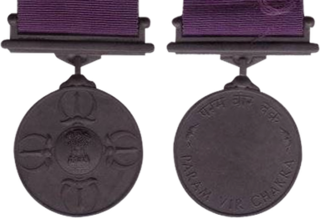
The Param Vir Chakra (PVC) is India's highest military decoration, awarded for displaying distinguished acts of valour during wartime. Param Vir Chakra translates as the "Wheel of the Ultimate Brave", and the award is granted for "most conspicuous bravery in the presence of the enemy". As of January 2018, the medal has been awarded 21 times, of which 14 were posthumous and 16 arose from actions in Indo-Pakistani conflicts. Of the 21 awardees, 20 have been from the Indian Army and one has been from the Indian Air Force. Major Somnath Sharma was the first recipient. A number of state governments of India as well as ministries of the central government provide allowances and rewards to recipients of the PVC.

Sergeant Joseph Harcourt Tombs VC, born Frederick Griffith Tombs, who under the name Joseph Tombs, was an English recipient of the Victoria Cross (VC), the highest award of the British (Imperial) honours system. The VC is awarded for ‘most conspicuous bravery … in the presence of the enemy’.
Company Sergeant Major John Henry Williams, was a Welsh colliery worker, soldier, and a recipient of the Victoria Cross (VC) the highest award for gallantry in the face of the enemy that can be awarded to British and Commonwealth forces. Williams is the most decorated Welsh non-commissioned officer of all time.

Edward Jennings VC was an Irish recipient of the Victoria Cross, the highest and most prestigious award for gallantry in the face of the enemy that can be awarded to British and Commonwealth forces.
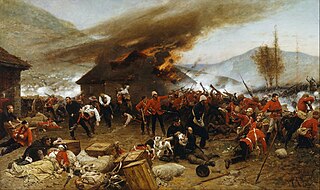
William Wilson Allen, VC was an English recipient of the Victoria Cross (VC) for his actions at the Battle of Rorke's Drift in January 1879, the highest and most prestigious award for valour in the face of the enemy that can be awarded to British and Commonwealth forces.
Umrao Singh Yadav was an Indian recipient of the Victoria Cross (VC), the highest and most prestigious award for gallantry in the face of the enemy that can be awarded to British and Commonwealth forces. He was a non-commissioned officer in the Royal Artillery or the Royal Indian Artillery to be awarded the Victoria Cross during the Second World War, and the last survivor of only 40 Indian soldiers to be awarded the VC between 1912, when Indians first became eligible to be awarded the VC, to Indian independence in 1947.

Major General Sir Henry Tombs VC KCB was a recipient of the Victoria Cross, the highest and most prestigious award for gallantry in the face of the enemy that can be awarded to British and Commonwealth forces.
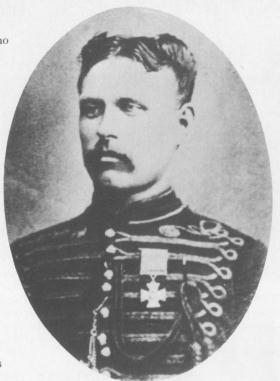
James Collis VC was an English recipient of the Victoria Cross, the highest award for gallantry in the face of the enemy that can be awarded to British and Commonwealth forces.

Thomas Lane VC was an Irish recipient of the Victoria Cross, the highest award for gallantry in the face of the enemy that can be awarded to British and Commonwealth forces.

George Albert Ravenhill VC was an English recipient of the Victoria Cross, the highest award for gallantry in the face of the enemy that can be awarded to British and other Commonwealth forces. Ravenhill is one of eight men whose VCs were involuntarily forfeited.
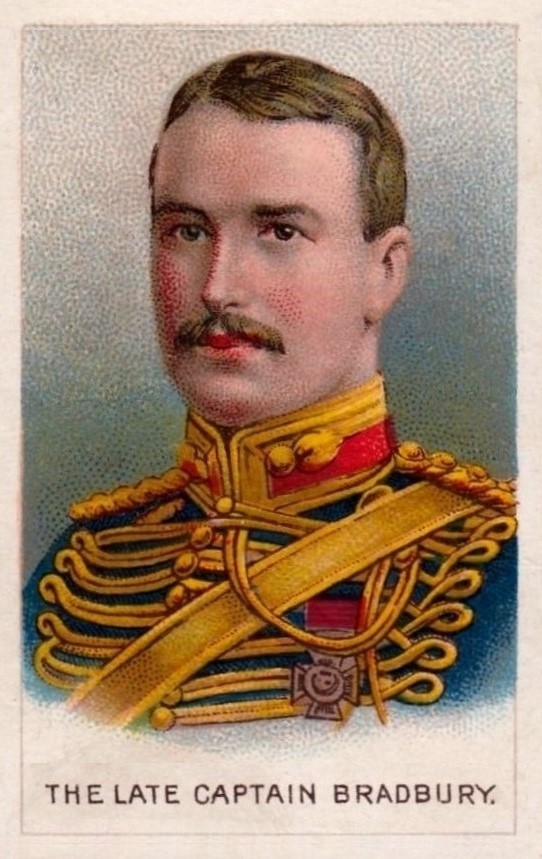
Captain Edward Kinder Bradbury VC was an English recipient of the Victoria Cross, the highest and most prestigious award for gallantry in the face of the enemy that can be awarded to British and Commonwealth forces.

Frederick Hitch, VC was an English recipient of the Victoria Cross for his actions at the Battle of Rorke's Drift, the highest award for gallantry in the face of the enemy that can be awarded to British and Commonwealth forces.

Lieutenant Colonel Arthur Frederick Pickard was a British Army officer and courtier. For his actions in New Zealand in 1863, he was awarded the Victoria Cross, the highest award for gallantry in the face of the enemy that can be awarded to British and Commonwealth forces. After further service and promotion in the Royal Artillery, Pickard was appointed an Equerry to the Duke of Connaught and Strathearn in 1871; seven years later, he was made Assistant Keeper of the Privy Purse and Assistant Private Secretary to the Queen and promoted to lieutenant colonel, but died of tuberculosis in France, aged 35, less than two years later.

Colonel Alfred Spencer Heathcote VC was an English recipient of the Victoria Cross.

Surgeon General William George Nicholas Manley, was a British Army officer, surgeon and a recipient of the Victoria Cross, the highest award for gallantry in the face of the enemy that can be awarded to British and Commonwealth forces. He received awards from several other countries, and is the only person to have been awarded both the VC and the Iron Cross.
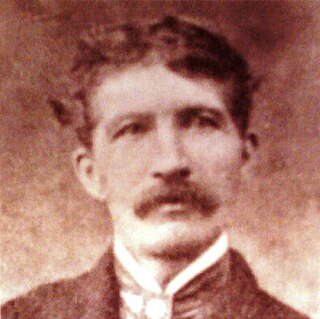
William Goate VC was an English recipient of the Victoria Cross.

Samuel Morley VC was an English recipient of the Victoria Cross ("VC"), the highest and most prestigious award for gallantry in the face of the enemy that can be awarded to British and Commonwealth forces.
The Victoria Cross for Australia is the highest award in the Australian honours system, superseding the British Victoria Cross for issue to Australians. The Victoria Cross for Australia is the "decoration for according recognition to persons who in the presence of the enemy, perform acts of the most conspicuous gallantry, or daring or pre-eminent acts of valour or self-sacrifice or display extreme devotion to duty."

The Victoria Cross (VC) is the highest and most prestigious decoration of the British honours system. It is awarded for valour "in the presence of the enemy" to members of the British Armed Forces and may be awarded posthumously. It was previously awarded by countries of the Commonwealth of Nations, most of which have established their own honours systems and no longer recommend British honours. It may be awarded to a person of any military rank in any service and to civilians under military command. No civilian has received the award since 1879. Since the first awards were presented by Queen Victoria in 1857, two thirds of all awards have been personally presented by the British monarch. The investitures are usually held at Buckingham Palace.

The Battle of Kafr El Dawwar was a conflict during the Anglo-Egyptian War near Kafr El Dawwar, Egypt. The battle took place between an Egyptian army, headed by Ahmed ‘Urabi, and British forces headed by Sir Archibald Alison. As a result, the British abandoned any hope they may have had of reaching Cairo from the north, and shifted their base of operations to Ismailia instead.
















